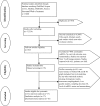The Significance of miRNAs as a Prognostic Biomarker for Survival Outcome in T Cell - Acute Lymphoblastic Leukemia Patients: A Systematic Review and Meta-Analysis
- PMID: 32104065
- PMCID: PMC7008181
- DOI: 10.2147/CMAR.S200687
The Significance of miRNAs as a Prognostic Biomarker for Survival Outcome in T Cell - Acute Lymphoblastic Leukemia Patients: A Systematic Review and Meta-Analysis
Abstract
Purpose: T-cell acute lymphoblastic leukemia (T-ALL) affects lymphoid cells. Previous studies have reported that miRNAs play a significant role in T-ALL prognosis and have the potential to function as biomarkers in T-ALL. Therefore, this systematic review and meta-analysis study was designed to evaluate the overall prognostic impact of miRNAs in T-ALL patients.
Methods: Eligible studies published between Jan 2010 and April 2018 were retrieved from online bibliographic databases based on multiple keywords to generate search strings. Meta-analysis was performed using the outcome measure, Hazard Ratio (HR). A survival analysis of all studies was conducted and a subsequent forest plot was generated to evaluate the pooled effect size, across all T-ALL patients. Subgroup analysis was conducted based on demographic characteristics and commonly represented miRNAs among the included studies.
Results: A total of 17 studies were included for systematic review, among which 16 studies were eligible for meta-analysis, which, in total discussed 32 different miRNAs. The mean effect size of HR value was 0.929 (CI 0.878-0984), which indicates a decrease in risk of death by 7.1%. The analysis was based on the random effects model with the heterogeneity measure index (I2) being 84.92%. The pooled effect size (HR) of upregulated and downregulated miRNA expressions on survival outcome in the T-ALL patient was 0.787 (CI 0.732-0.845) and 1.225 (CI 1.110-1.344) respectively. The subgroup analysis was performed based on demographic characteristics (age, gender, lactate dehydrogenase, WBC count) and expression of miR221 and miR46a.
Conclusion: Our systematic review and meta-analysis findings suggest that the overall miRNA expression is potentially associated with a decreased likelihood of death in T-ALL patients. Although our findings are inconclusive, the results point toward miRNA expression allowing for prognostic evaluation of T-ALL patients.
Keywords: PRISMA; biomarkers; microRNAs; prognosis; survival analysis.
© 2020 Sabarimurugan et al.
Conflict of interest statement
The authors report no conflicts of interest in this work.
Figures












References
-
- Harris NL, Jaffe ES, Diebold J, et al. World Health Organization classification of neoplastic diseases of the hematopoietic and lymphoid tissues: report of the Clinical Advisory Committee meeting-Airlie House, Virginia, November 1997. J Clin Oncol. 1999;17(12):3835–3849. doi:10.1200/JCO.1999.17.12.3835 - DOI - PubMed
LinkOut - more resources
Full Text Sources
Miscellaneous

